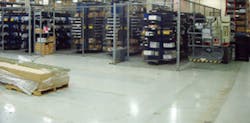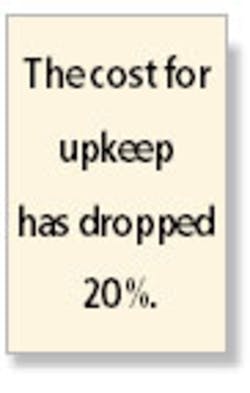conductive Tile Forms Foundation for Static-Control Program
An industry-leading manufacturer focused on flooring when developing a comprehensive ESD control program.
In 2000, National Instruments (NI) was in an expansion mode. The company was moving forward with a capital improvement project at its headquarters in Austin, TX, and planning its first manufacturing plant overseas.
But in Austin, persistent flooring problems focused attention on a fundamental issue electrostatic discharge (ESD) control. As it turned out, a new overseas plant offered the first opportunity to try a different kind of flooring which would provide better ESD control.
NI was founded in Austin in 1976 to provide software and hardware solutions that link computers to specialized laboratory instruments. Today, the company is widely recognized for its LabVIEW graphical development software, which scientists and engineers can use to create virtual instruments for measuring pressure, temperature, voltage, and other physical phenomena.
In 1995, NI moved to a 69-acre complex located in a manufacturing area. The company installed an epoxy flooring and footwear system for ESD control. As part of the program, each worker seated at a workstation wore a wrist strap that was continuously monitored for any loss of grounding, and ESD bags and totes were used to transport sensitive items and ship products.
Problems With Flooring
After a couple of years, signs of deterioration were observed in the flooring (Figure 1). The cream-colored epoxy had bubbled and popped in places, exposing nickel-sized patches of concrete. As time went on, the patches grew larger, and cracks appeared. The epoxy around drainage holes and electrical outlets in the floor chipped away and left gaps.
In 1999, a second coating of epoxy was applied to the entire floor, covering the holes and cracks. But it was not long before the problems reappeared. Possible causes were considered that included unusually heavy traffic and wear, improper installation, a faulty batch of epoxy, and moisture seeping up from the earth.
Whatever the cause, the simplest and least expensive solution was to apply a third coating of epoxy. This time, however, bits of debris including screws and components were detected under the coating, which raised questions about whether the floor had been cleaned beforehand. Worse, in some places, the feet of equipment were found stuck to the floor, which meant that when the equipment was moved, epoxy peeled off the floor.
To ensure ESD protection, a special wax was applied to the deteriorated sections of the floor. Sensitive product lines were set up only in well-grounded areas, and the wearing of wrist straps at workstations was strictly enforced. But these were stopgap measures.
More importantly, NI wanted to continue as a world-class manufacturer. The company's new research and design center was scheduled to open soon at the Austin headquarters, and construction had started on the company's first overseas plant in Debrecen, Hungary.
Exploring the Options
NI engineers recognized that comprehensive ESD protection would require a first-rate flooring and footwear system. One option was a different ESD epoxy.
Ordinarily, epoxy is harder than other flooring and recommended for areas where heavy equipment is used and machines are reshuffled frequently to accommodate changing production lines. But experience had shown that new epoxy would probably have to be installed every four years. At $2.50/sq ft per application, the flooring would cost $7.50/sq ft over 12 years, not to mention the losses incurred for interrupting production each time.
Another option was ESD tile. NI employees who had worked at other companies told of their experiences with ESD tile made by 3M. Tile was appealing: If two or three tiles were damaged when equipment was moved, they could be replaced easily.
NI engineers calculated that the tile would cost an estimated $3.05/sq ft and believed that the tile would last at least 12 years or even longer. In addition, companies using the 3M tile spoke of cost savings from low maintenance.
To guard against problems incurred in the past, including the possibility of moisture seepage, it was decided that all the old epoxy would be stripped and a vapor barrier applied. This preparation added $6/sq ft to both options.
Hungary Plant Offers Opportunity
The new plant in Hungary was expected to replicate the facilities and processes used in Austin. Because of problems with the epoxy flooring in Austin, however, engineers took the opportunity to try ESD tile. NI Hungary installed approximately 70,000 sq ft of 3M 8400 Conductive Tile, and, in October 2001, the plant opened.
Process engineers from Austin who traveled to Hungary at six-month intervals reported success with the tile. It provided excellent electrical protection with resistance consistently measuring below 1 MW to ground. The tile stayed white, clean, and bright with proper routine cleaning and buffing.
That experience prompted NI to install 45,000 sq ft of the same tile in the Austin manufacturing facility (Figure 2). To minimize disruption, the company asked the installer, ICT Construction and Technology, to do the job in two stages, each over a six-day holiday weekend: the production area over the Fourth of July in 2003 and the warehouse over New Year's Day 2004.
During each stage, ICT divided the floor into quadrants. One quadrant was cleared for installation, one held the moved equipment, and the other two had assembly lines working as usual.
After installation, 3M technicians certified the resistance-to-ground at below 1 MΩ As part of the flooring protection system, all workers and visitors in the manufacturing area wear heel straps on both shoes. Carpeted spaces in the plant are equipped with 3M static-control mats.Although a flooring/footwear system provides a large zone of protection, the ESD control program still requires seated workers to wear wrist straps that are continuously monitored. To further upgrade ESD control, ionizers were installed in some production lines where plastics and other nonconductors are used.
Some of the hipot test workstations, for example, have a 3M 990 Overhead Ionizer that blankets the workbench below and neutralizes static charge. In other stations, workers use the 3M 980 Hand-Held Air Ionizer Gun to blow particulates off sensitive surfaces.
Lower Maintenance CostsThe cost for upkeep has dropped 20%. The old floor, which was deep-cleaned every weekend, required waxing in some areas. The new floor gets a deep cleaning on weekends and, because of the lower maintenance, a light weekday cleaning was added to the schedule. Even with this addition, yearly maintenance expense fell from $25,265 to $20,717.
About the Authors
Miles Matheny has worked at NI for 15 years. He is a staff manufacturing program analyst and serves as the ESD coordinator. 512-683-8650, e-mail: [email protected]
Alan Heckler, lead industrial engineer, has worked at NI for four years. He holds a bachelor's degree in industrial engineering from Texas Tech University. 512-683-8298, e-mail: [email protected]
Mohammad Sattar, the process improvement and industrial engineering manager at NI, graduated from the University of Texas with a master's degree in manufacturing systems engineering. He has been with NI for 10 years. 512-683-8256, e-mail: [email protected] National Instruments, 11500 N. Mopac Expressway, Austin, TX 78759
FOR MORE INFORMATION
on 3M ESD floor tiles
www.rsleads.com/502ee-176



